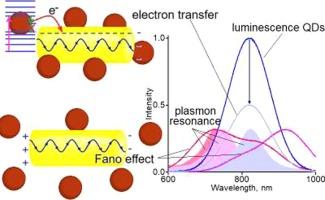等离子体-激子相互作用对金纳米棒附近Ag2S量子点红外发光的影响
IF 3.6
3区 物理与天体物理
Q2 OPTICS
引用次数: 0
摘要
等离子体-激子相互作用的研究在热光传感、光热催化、计算系统的热超表面、光信息编码和记录系统等光子技术中得到了广泛的应用。研究结果表明,在2-巯基丙酸钝化的金属金纳米棒(NRs)附近,平均尺寸为2.8 nm的胶体Ag2S量子点(QDs)在NRs消光和QDs发光的调谐/失谐光谱共振条件下,等离子体-激子相互作用。实验证明,Ag2S量子点的发光特性与发光带与等离子体共振峰的重叠程度有关。在光谱共振条件下,Ag2S量子点的发光在不改变发光带光谱线形状的情况下被猝灭。根据时间分辨发光数据,这种规律性是紧密间隔的混合物组分之间光诱导电荷转移的结果。等离子体-激子结构组分的光谱共振失谐导致Ag2S量子点发光带在短波长都存在猝灭和不对称性。在半经典模型框架下,实现了Ag2S量子点在Au核磁共振区附近发光的理论建模。本文总结了法诺效应的表现,并对等离子体激子混合物组分之间的平均距离色散进行了分析。因此,考虑到等离子体-激子相互作用的结果,Ag2S量子点的发光特性可以被调谐并用作热等离子体应用的发光传感器。本文章由计算机程序翻译,如有差异,请以英文原文为准。

Effect of plasmon-exciton interaction in IR luminescence of Ag2S quantum dots near Au nanorods for luminescent thermometry
The actions of plasmon-exciton interaction are of great researchers' interest due to their application in photonic technologies, including the thermo-optical sensorics, photothermal catalysis, thermal metasurfaces for computing systems, optical information coding and recording systems. The work presents the results of studies demonstrating plasmon-exciton interaction in ensembles of colloidal Ag2S quantum dots (QDs) with an average size of 2.8 nm near metal Au nanorods (NRs), passivated with 2-mercaptopropionic acid under conditions of tuning/detuning spectral resonances in the NRs extinction and QDs luminescence. It is experimentally established that the luminescent properties of Ag2S QDs dependence on the overlap degree of the luminescence band with plasmon resonance peak. Under spectral resonance conditions, Ag2S QDs luminescence was quenched without changing the spectral line shape of luminescence band. Based on time-resolved luminescence data, this regularity is the result of photoinduced charge transfer between closely spaced mixture components. Detuning of spectral resonances of plasmon-exciton structure components leads to the luminescence quenching and asymmetry of Ag2S QDs luminescence band in both short and long wavelengths. Theoretical modeling of the Ag2S QDs luminescence near Au NRs in the framework of a semiclassical model was realized. It is concluded about the manifestation of the Fano effect, complicated by the average distance dispersion between the components of the plasmon-exciton mixture. Thus, the luminescent properties of Ag2S QDs near Au NRs can be tuned and used as luminescent sensors for thermoplasmonics applications taking into account their transformation as a result of plasmon-exciton interaction.
求助全文
通过发布文献求助,成功后即可免费获取论文全文。
去求助
来源期刊

Journal of Luminescence
物理-光学
CiteScore
6.70
自引率
13.90%
发文量
850
审稿时长
3.8 months
期刊介绍:
The purpose of the Journal of Luminescence is to provide a means of communication between scientists in different disciplines who share a common interest in the electronic excited states of molecular, ionic and covalent systems, whether crystalline, amorphous, or liquid.
We invite original papers and reviews on such subjects as: exciton and polariton dynamics, dynamics of localized excited states, energy and charge transport in ordered and disordered systems, radiative and non-radiative recombination, relaxation processes, vibronic interactions in electronic excited states, photochemistry in condensed systems, excited state resonance, double resonance, spin dynamics, selective excitation spectroscopy, hole burning, coherent processes in excited states, (e.g. coherent optical transients, photon echoes, transient gratings), multiphoton processes, optical bistability, photochromism, and new techniques for the study of excited states. This list is not intended to be exhaustive. Papers in the traditional areas of optical spectroscopy (absorption, MCD, luminescence, Raman scattering) are welcome. Papers on applications (phosphors, scintillators, electro- and cathodo-luminescence, radiography, bioimaging, solar energy, energy conversion, etc.) are also welcome if they present results of scientific, rather than only technological interest. However, papers containing purely theoretical results, not related to phenomena in the excited states, as well as papers using luminescence spectroscopy to perform routine analytical chemistry or biochemistry procedures, are outside the scope of the journal. Some exceptions will be possible at the discretion of the editors.
 求助内容:
求助内容: 应助结果提醒方式:
应助结果提醒方式:


